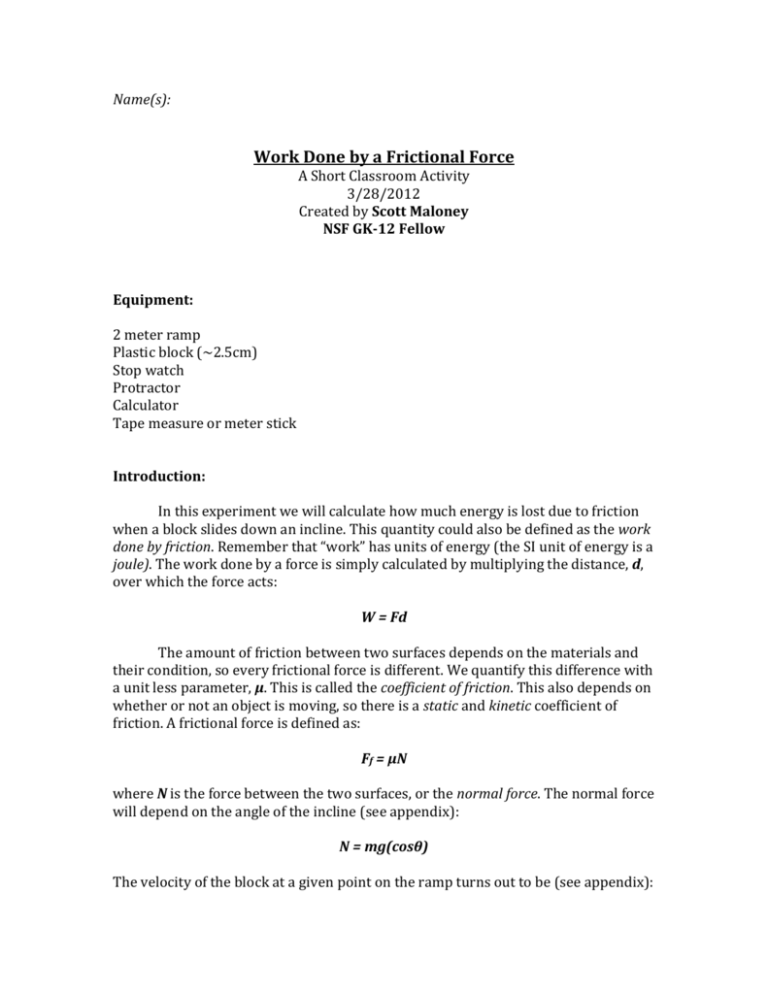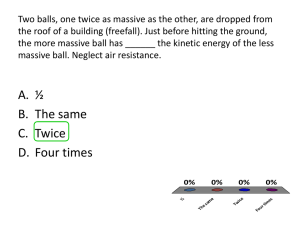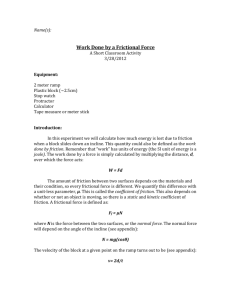Work Done by a Frictional Force
advertisement

Name(s): Work Done by a Frictional Force A Short Classroom Activity 3/28/2012 Created by Scott Maloney NSF GK-12 Fellow Equipment: 2 meter ramp Plastic block (~2.5cm) Stop watch Protractor Calculator Tape measure or meter stick Introduction: In this experiment we will calculate how much energy is lost due to friction when a block slides down an incline. This quantity could also be defined as the work done by friction. Remember that “work” has units of energy (the SI unit of energy is a joule). The work done by a force is simply calculated by multiplying the distance, d, over which the force acts: W = Fd The amount of friction between two surfaces depends on the materials and their condition, so every frictional force is different. We quantify this difference with a unit less parameter, μ. This is called the coefficient of friction. This also depends on whether or not an object is moving, so there is a static and kinetic coefficient of friction. A frictional force is defined as: Ff = μN where N is the force between the two surfaces, or the normal force. The normal force will depend on the angle of the incline (see appendix): N = mg(cosθ) The velocity of the block at a given point on the ramp turns out to be (see appendix): v= 2d/t where t is the time the block takes to slide to a distance, d, down the ramp. To calculate how much energy is lost in a system with friction we start with the idea of conservation of energy, which says that the total energy at the beginning equals the total energy at the end: Energy at the beginning = Energy at the end Our choice of “beginning” and “end” are arbitrary. If there was no friction, the potential energy at the top of the ramp (before the block starts moving) would be completely transformed to kinetic energy at the bottom: Potential energy at the top = Kinetic energy at the bottom or mgh = ½mv2 (frictionless system) where m is the mass of the block, g is the acceleration due to gravity, h is the height to the top of the ramp (from the floor), and v is the speed of the block at the bottom. But we know there IS friction, and the friction will cause an energy loss. Friction will slow the motion of the block down the ramp so there will be less kinetic energy at the bottom. Using the idea of conservation of energy again: Potential = Kinetic + Energy lost to friction Or mgh = ½mv2 + μNd So the energy lost to friction, or the work done by friction, is: μNd = m(gh - ½v2) Now we can measure all the quantities on the right side of this equation to determine how much energy is lost when a block slides down an incline. Procedures: 1.) In the space below, draw a labeled diagram of the block/ramp system: 2.) Set up the ramp so it is at an angle of 25° relative to the floor 3.) Hold the block at the very top of the ramp. Be ready with the stopwatch 4.) Release the block and time how long it takes to get to the bottom. Record your data in the table below and calculate the average time and speed. Trial # Time (sec) 1 2 Average time: ______________(s) 3 Average speed: ______________(m/s) 4 5 Discussion: 1.) How much energy was lost due to friction? 2.) Where did the energy go? 3.) Could you calculate μ from this information? How? Is this the static or kinetic coefficient of friction? 4.) Look at the table below. How does the value you calculated compare with these examples? Energy required to make a grain of sand jump 1cm K.E. of penny falling 1m K.E. of penny falling at terminal velocity Electrical energy required to run a 60 watt light bulb for 1 minute K.E. of bullet fired from a typical 9mm 1×10-9 J 0.03 J 0.15 J 3600 J 5700 J K.E. of 1-ton car moving at 55mph K.E. of armor piercing round fired from assault rifle of an ISU-152 tank 3×105 J Average energy in a lightning bolt 5×109 J Energy released from the “Fat Man” atom bomb in WWII Total solar energy that strikes Earth’s surface every second Yearly electrical energy consumption in the US Yearly electrical energy consumption in the world 1×107 J 8.8×1013 J 1.7×1017 J 1.4×1019 J 6.4×1019 J 5.) What “real world” applications can you think where you would need to calculate changes in a system due to friction? Math Appendix: The relationships between the lengths of the sides of a right triangle and the angles between them is given by the diagram below: In our system, the weight of the block, mg, was the hypotenuse, and N was adjacent to θ: cosθ = N/mg N = mg(cosθ) To calculate the velocity, v, we start with two very important equations of 1dimensional motion: x = xo + vot + ½at2 and vf2 = vo2 + 2a(x-xo) Here, x is the total distance an object travels, xo is the initial position, vo is the initial velocity, a is its acceleration (which must be constant for these equations to work), and t is the travel time. For our system, we defined xo as zero (the position of the block at the top of the ramp) and the distance, x, we called d, which was 2 meters. The block started at rest so vo is also zero. The term, vf , represents the final velocity of the object, which we just called v. Make these substitutions and you will see our first two equations reduce very nicely to: d = ½at2 and v2 = 2ad Take the first equation for d and solve for a: a = 2d/t2 Putting this into the next equation and taking the square root of both sides gives us our equation for v: v2 = 2(2d/t2)d = 4d2/t2 v = (4d2/t2)½ v = 2d/t








